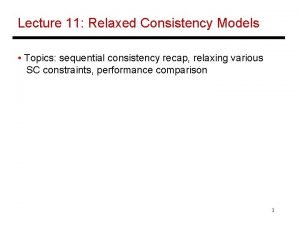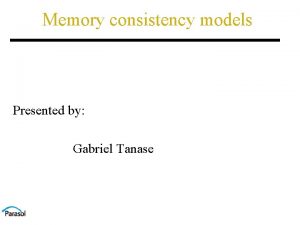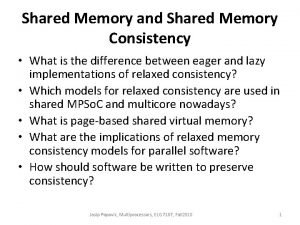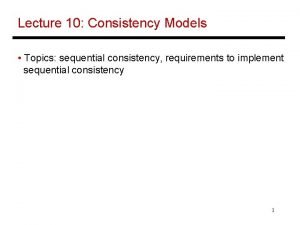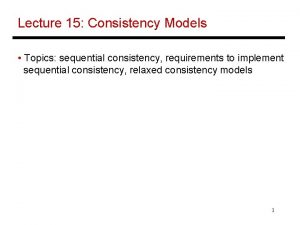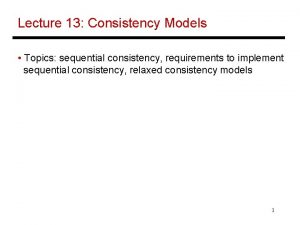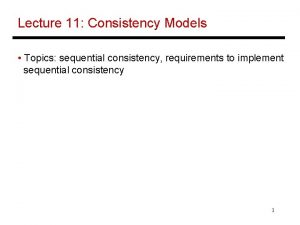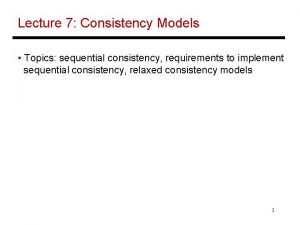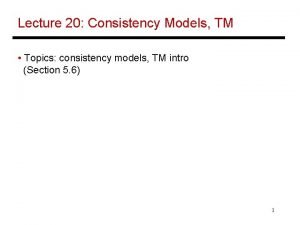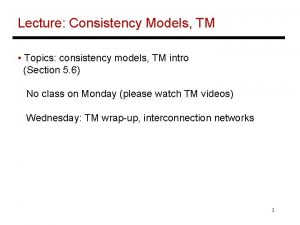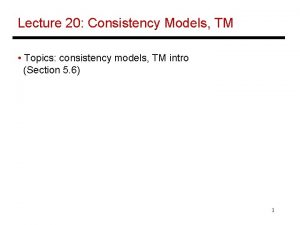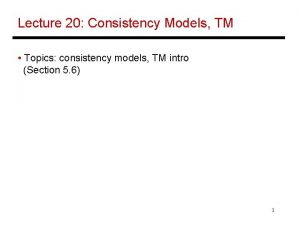Lecture 12 Relaxed Consistency Models Topics sequential consistency















- Slides: 15

Lecture 12: Relaxed Consistency Models • Topics: sequential consistency recap, relaxing various SC constraints, performance comparison 1

Relaxed Memory Models • Recall that sequential consistency has two requirements: program order and write atomicity • Different consistency models can be defined by relaxing some of the above constraints this can improve performance, but the programmer must have a good understanding of the program and the hardware 2

Potential Relaxations • Program Order: (all refer to different memory locations) Ø Write to Read program order Ø Write to Write program order Ø Read to Read and Read to Write program orders • Write Atomicity: (refers to same memory location) Ø Read others’ write early • Write Atomicity and Program Order: Ø Read own write early 3

Write Read Program Order • Consider three example implementations that relax the write to read program order: Ø IBM 370: a read can complete before an earlier write to a different address, but a read cannot return the value of a write unless all processors have seen the write Ø SPARC V 8 Total Store Ordering (TSO): a read can complete before an earlier write to a different address, but a read cannot return the value of a write by another processor unless all processors have seen the write (it returns the value of own write before others see it) Ø Processor Consistency (PC): a read can complete before an earlier write (by any processor to any 4 memory location) has been made visible to all

Relaxations Relaxation W R Order IBM 370 X TSO X PC X W W R RW Rd others’ Wr Order early Rd own Wr early X X X Ø IBM 370: a read can complete before an earlier write to a different address, but a read cannot return the value of a write unless all processors have seen the write Ø SPARC V 8 Total Store Ordering (TSO): a read can complete before an earlier write to a different address, but a read cannot return the value of a write by another processor unless all processors have seen the write (it returns the value of own write before others see it) Ø Processor Consistency (PC): a read can complete before an earlier write (by any processor to any memory location) has been made visible to all 5

Examples Initially, A=Flag 1=Flag 2=0 P 1 P 2 Flag 1=1 Flag 2=1 A=2 register 1=A register 3=A register 2=Flag 2 register 4=Flag 1 Result: reg 1=1; reg 3=2; reg 2=reg 4=0 Relaxation W R Order IBM 370 X TSO X PC X P 1 A=1 Initially, A=B=0 P 2 P 3 if (A==1) B=1 if (B==1) register 1=A Result: B=1, reg 1=0 W W R RW Rd others’ Wr Order early Rd own Wr early X X X 6

Safety Nets • To explicitly enforce sequential consistency, safety nets or fence instructions can be used • Note that read-modify-write operations can double up as fence instructions – replacing the read or write with a r-m-w effectively achieves sequential consistency – the read and write of the r-m-w can have no intervening operations and successive reads or successive writes must be ordered in some of the memory models 7

Optimizations Enabled • W R : takes writes off the critical path • W W: memory parallelism (bandwidth utilization) • R WR: non-blocking caches, overlaps other useful work with a read miss 8

Weak Ordering • An example of a model that relaxes all of the above constraints (except reading others’ write early) • Operations are classified as data and synchronization • A counter tracks the number of outstanding data operations and does not issue a synchronization until the counter is zero; data ops cannot begin unless the previous synchronization op has completed 9

Release Consistency • RCsc relaxes constraints similar to WO, while RCpc also allows reading others’ writes early • More distinctions among memory operations Ø RCsc maintains SC between special, while RCpc maintains PC between special ops Ø RCsc maintains orders: acquire all, all release, special Ø RCpc maintains orders: acquire all, all release, special, except for sp. wr followed by sp. rd shared sync acquire special nsync release ordinary 10

Programmer Viewpoint • Weak ordering will yield high performance, but the programmer has to identify data and synch operations • An operation is defined as a synch operation if it forms a race with another operation in any seq. consistent execution • Given a seq. consistent execution, an operation forms a race with another operation if the two operations access the same location, at least one of them is a write, and there are no other intervening operations between them P 1 Data = 2000 Head = 1 P 2 while (Head == 0) { } … = Data 11

Performance Comparison • Taken from Gharachorloo, Gupta, Hennessy, ASPLOS’ 91 • Studies three benchmark programs and three different architectures: § MP 3 D: 3 -D particle simulator § LU: LU-decomposition for dense matrices § PTHOR: logic simulator Ø LFC: aggressive; lockup-free caches, write buffer with bypassing Ø RDBYP: only write buffer with bypassing Ø BASIC: no write buffer, no lockup-free caches 12

Performance Comparison 13

Summary • Sequential Consistency restricts performance (even more when memory and network latencies increase relative to processor speeds) • Relaxed memory models relax different combinations of the five constraints for SC • Most commercial systems are not sequentially consistent and rely on the programmer to insert appropriate fence instructions to provide the illusion of SC 14

Title • Bullet 15
 Relaxed consistency
Relaxed consistency Sequential consistency
Sequential consistency Eventual consistency vs strong consistency
Eventual consistency vs strong consistency Sequential sampling models
Sequential sampling models Client-centric consistency
Client-centric consistency Memory consistency
Memory consistency Client-centric consistency models
Client-centric consistency models Shared memory consistency models a tutorial
Shared memory consistency models a tutorial 01:640:244 lecture notes - lecture 15: plat, idah, farad
01:640:244 lecture notes - lecture 15: plat, idah, farad Benefits of a relaxed work environment
Benefits of a relaxed work environment Relaxed cone step mapping
Relaxed cone step mapping What is copy number of plasmid
What is copy number of plasmid Muscle structure
Muscle structure A guest with relaxed inhibitions may
A guest with relaxed inhibitions may School nowadays
School nowadays Bottom hem measurement
Bottom hem measurement
